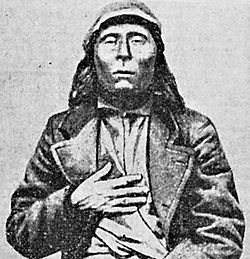Paulina (Paiute leader) facts for kids
Quick facts for kids
Chief Paulina
|
|
|---|---|
|
Pahninee
|
|

Chief Paulina, circa 1865
|
|
| Northern Paiute leader | |
| Personal details | |
| Born | November 13, 1833 Location unknown |
| Died | April 25, 1867 (aged 33) Jefferson County, Oregon |
| Cause of death | Shot by Howard Maupin or James Clark |
| Resting place | Unmarked location |
Chief Paulina, also known as Pahninee, was an important leader of the Northern Paiute people. He was known for his clever guerrilla tactics. These are surprise attacks and quick movements. Paulina was active from 1859 until he passed away in 1867.
Contents
Paulina's Fight for His People's Land
During the late 1850s and 1860s, Paulina led a group of Northern Paiutes. They strongly resisted people moving onto their lands. His group did not want to move to a Native American reservation. They attacked settlers who were traveling through or living on Paiute lands. These lands were in central and eastern Oregon and the Klamath Basin.
Why Paulina Became a Notorious Leader
Paulina became the most well-known leader in these conflicts. He was famous for how fast his attacks were. He was also good at avoiding capture by soldiers. Both volunteer groups and the U.S. Army tried to catch him. Paulina led a small group, which included his brother Wahveveh. They would raid and take livestock and horses. This caused fear in nearby communities. His group also attacked Native Americans living on the Warm Springs Indian Reservation.
Some people believe Paulina's strong feelings against the Warm Springs Indians and settlers began in April 1859. At that time, Dr. Thomas Fitch led Native Americans from the Warm Springs Reservation. They attacked a group of Paiutes near the John Day River. Ten Paiute warriors were killed. The women, children, and the rest of the group were captured. Paulina and Wahveveh were among those captured. They were sent to Fort Dalles but were held for only a short time.
Battles and Conflicts Increase
Captain John M. Drake led one of the first army actions in the area. Paulina's group defeated an army attack near Juniper Butte. After this, the conflicts became more frequent. The Paiute resistance was split into two main groups. One was led by Paulina, from the Walpapi band. The other was led by Weahwewa, from the Kidutokado band.
In one event, Paulina set up peace talks with the Chief of the Wascos, Queapama. However, during these talks, Paulina had one of his warriors kill Queapama. Groups like Paulina's gained from these attacks. But they also made the fighting worse. This led to more violence and deaths in the region. All groups living there—settlers, Native American communities at Warm Springs and Umatilla, and the Northern Paiute—fought back. This resulted in many people losing their lives.
Treaty and Escape from the Reservation
U.S. Army forces captured some Paiute people. They held them prisoner at Fort Klamath. Paulina's sister, wife, and son were among them. Because of this, Paulina and other leaders of the Hunipuitöka Paiute agreed to sign a treaty in early 1865.
However, Paulina and his group left the Klamath Reservation on April 22, 1866. They felt the treaty was unfair. They also needed to find food to avoid starvation. After they left, Howluck contacted Paulina. Howluck was looking for help to get revenge. His followers had been killed by California troops in the Guano Valley.
Paulina's Last Stand at Burnt Ranch
On September 15, 1866, Paulina and his group of fourteen Paiutes attacked a ranch. This ranch belonged to James N. Clark. It was located near the meeting point of Bridge Creek and the John Day River. The attackers burned the house and stables. They also burned 40 short tons (36,000 kg) of hay and 1,000 imperial bushels (36 kl) of oats and barley. They stole two horses and a cow. The damage was estimated to be about $6,494.
Clark's wife was visiting her parents at the time. An unarmed Clark and his 18-year-old brother-in-law were collecting wood. They were by the John Day River when they saw the Paiutes. Paulina and his group spotted them and chased them. Clark managed to get away. His brother-in-law hid in the river for several hours. Only his nose was out of the water. He was not found, but he almost got hypothermia.
Clark gathered a group of settlers to try and get some of his stolen property back. One year after Paulina left the Klamath Reservation, on April 25, 1867, Clark shot Paulina. This was part of a revenge attack led by settlers and Howard Maupin. Paulina's last fight happened at a place now called Paulina Basin. This area is in northeastern Jefferson County, near the town of Ashwood, Oregon. Howard Maupin claimed he was the one who killed Paulina.

